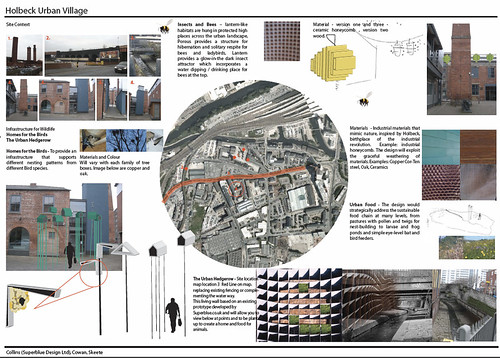 Our London design team, comprising Annick Collins (superblue) Gregory Cowan and Natalie Skeete, has have been shortlisted for the Holbeck competition scheme submitted in February. (Design Week)
Our London design team, comprising Annick Collins (superblue) Gregory Cowan and Natalie Skeete, has have been shortlisted for the Holbeck competition scheme submitted in February. (Design Week)The competition entry prepared by Collins Cowan and Skeete proposes a triadic strategy of landscape, urban 'furniture' and a palette of suitable materials, where non-humans and humans will interact. The final result is due to be announced on the 28th of May.
Designing animal habitats for Holbeck Urban Village seemed an excellent idea for a collaboration on a design competition. Annick, my engineer colleague, and one of a trio with whom I had worked on the Ken Saro-Wiwa Mobile Memorial competition, agreed to collaborate at the end of 2008. Near Camley Street , a model inner city nature interaction space, we talked over a pint of London Pride about human-animal and animal-human interaction in this 'urban regeneration' area, and found consensus on issues like biomimicry, and human-centred urban design principles which might also allow birds to nest, bees to pollenate, and otters to hide from human residents of the area. Architectural assistant Natalie Skeete, who had been working in the same regeneration area by the Fleet, and on the new Kings Place building by the canal, joined the team, adding her experience of nocturnal animal architecture.
A discussion about the transdisiplinary work of OOZ was brought my attention by a neighbour commentating on the work. Geese, Birds, Fish and Bats had been studied and discussion ensued about human and non-human interactions.
Our team finalised and submitted our three part strategy proposal in February, and in March our team was shortlisted, among a field of competitors from Yorkshire, California, and beyond. We met by the canal again to consider the shortlisting, and offered the competition organisers the opportunity that we would engage the local community. Our process-driven design strategy, which combines urban landscape, animal 'furniture' and a code of materials will not easily translate into a photo opportunity. The press article says "The winner, who will be announced on May 28, will see his or her vision turned into reality and installed in Holbeck Urban Village ready for local critters to move in." But do the organisers understand the need to work with the existing resident human critters?
Whether our scheme will be suitable for building a photogenic prototype for the 'critters' - as the organisers envisage - remains to be seen.
Links:
- Group picture
- Holbeck Tour: and 18 part zipped Audio Guide
- Biomimicry at the AIA 2007 Convention
- Presentation about OOZ
- Ecological sustainability
- The Biomimicry Institute and its ask.nature website
- Hilary Powell's 2007 photographs of the site


